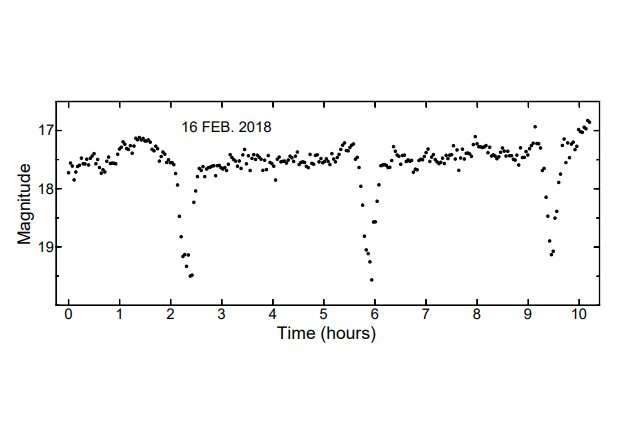December 27, 2019 report
Deep eclipses detected in the cataclysmic variable J0130

Russian astronomer Valery Kozhevnikov has conducted photometric observations of the cataclysmic variable (CV) IPHAS J013031.89+622132.3 (J0130 for short), finding that the object exhibits deep eclipses. The discovery, presented in a paper published December 17 on arXiv.org, could provide more clues on the nature of this CV.
CVs are binary star systems consisting of a white dwarf (WD) and a normal star companion transferring material to the WD (in some cases through accretion discs). They irregularly increase in brightness by a large factor, then drop back down to a quiescent state. Observations prove that CVs with high orbital inclination (over 60 degrees) showcase eclipses.
Finding eclipses in cataclysmic variables and studying them in detail is important for several reasons. Such studies could determine orbital period, orbital inclination and mass of components in these systems. Moreover, they could provide insights into the structure and time evolution of accretion discs in CVs.
Now, Valery Kozhevnikov Ural Federal University (UrFU), Russia, reports the discovery of very deep eclipses in J0130, a so-far poorly studied cataclysmic variables. The detection was a result of photometric observations using the 70-cm Cassegrain telescope and the multi-channel pulse-counting photometer at UrFU's Kourovka observatory.
"I performed photometric observations of the cataclysmic variable J0130 and detected very deep eclipses for the first time," Kozhevnikov wrote in the paper.
The astronomer found that the eclipses in J0130 are, indeed, very deep, given that their average depth is 1.88 mag. Such deep eclipses may suggest that this CV is a polar, however, this scenario was ruled out by Kozhevnikov, as the object shows no significant brightness variations outside of eclipses.
Kozhevnikov found that the prominent parts of the eclipses in J0130 were smooth and symmetrical. The eclipses were also found to have extended asymmetric wings. Kozhevnikov noted that the average width of the eclipses, including the wings, is 0.18 phases what equals to 40 minutes.
The collected data allowed the astronomer to determine the orbital period of J0130 with high precision. He found that its orbital period is approximately 0.149 days. Thanks to the precise measurement, the eclipse ephemeris was derived with a formal validity of 300 years.
Given that the observations have not identified any orbital humps and outbursts, Kozhevnikov concluded that J0130 most likely belongs to a subgroup of CVs known as nova-like variables.
"The average orbital light curve did not show a prominent orbital hump. Because no dwarf nova outburst occurred during the six months of monitoring, this cataclysmic variable is likely to be a nova-like variable," the researcher explained.
He added due to deep eclipses, J0130 is suitable for studies of the accretion disc structure using eclipse mapping methods. In general, further observations of this CV are needed in order to get more information about its other fundamental parameters like stellar masses of its components.
More information: Discovery of deep eclipses in the cataclysmic variable IPHAS J013031.89+622132.3, arXiv:1912.07978 [astro-ph.SR] arxiv.org/abs/1912.07978
© 2019 Science X Network




















